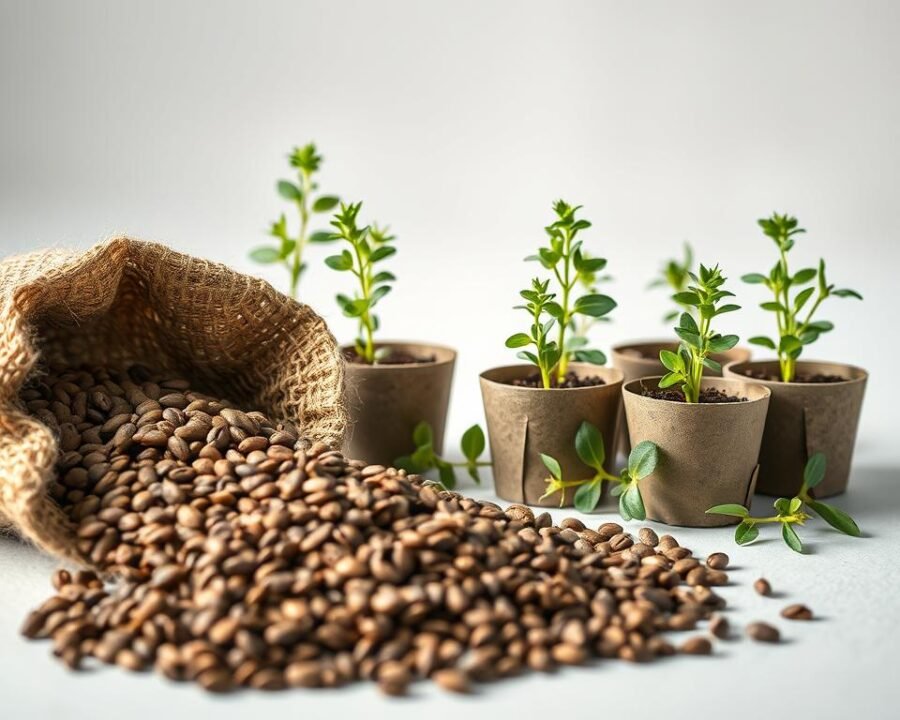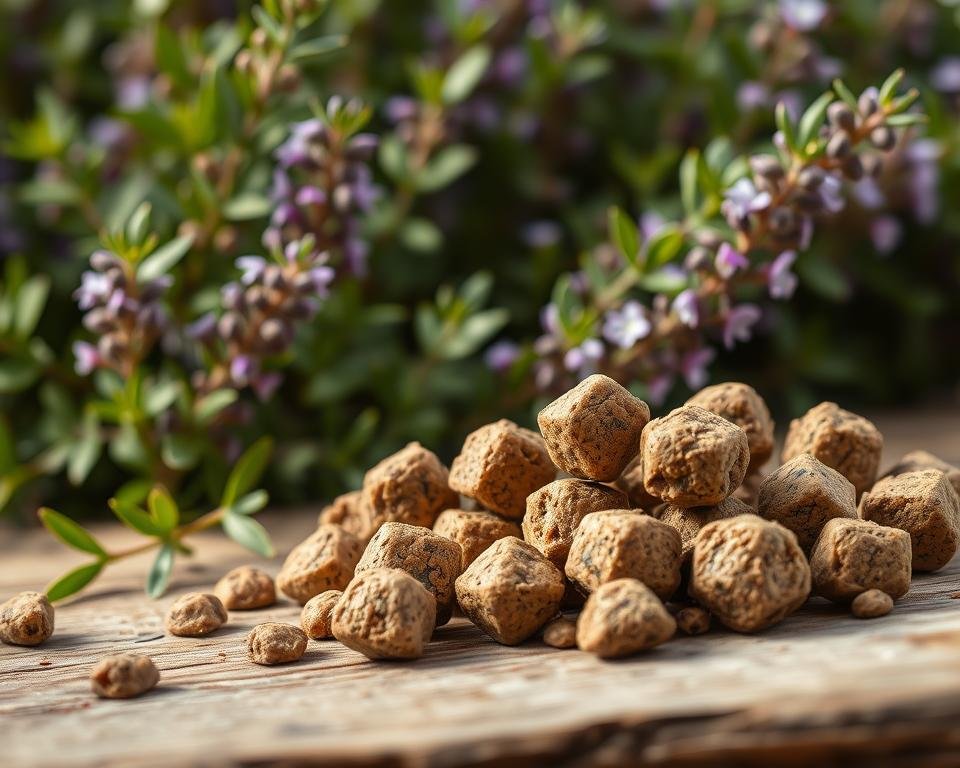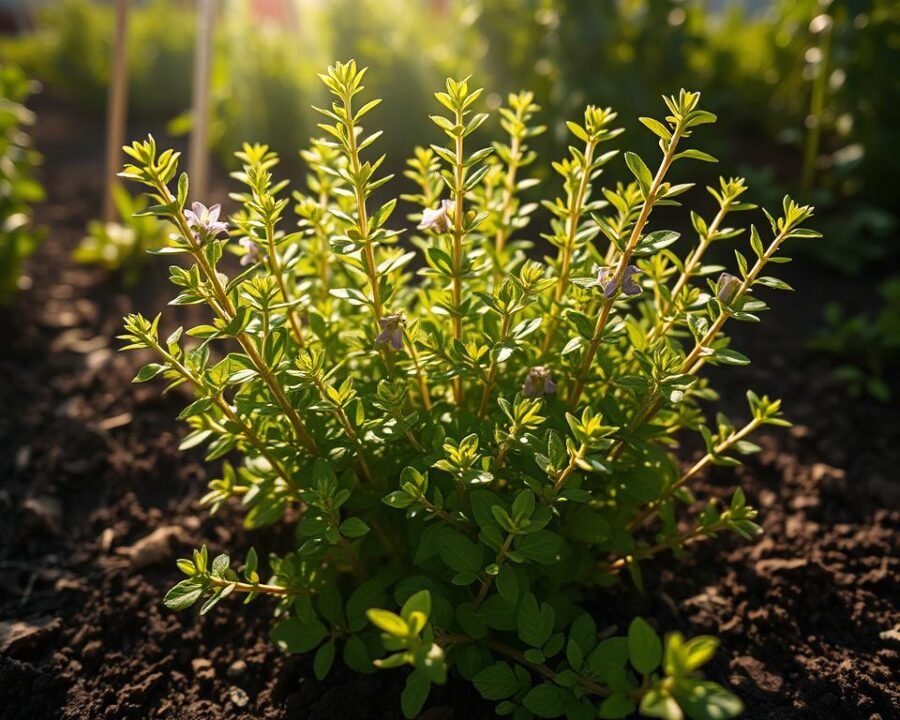There’s something magical about stepping into a garden and plucking fresh leaves straight from the earth. Oregano, with its earthy aroma and bold flavor, transforms meals and remedies alike. Whether sprinkled over pizza or brewed into tea, this Mediterranean treasure has earned its place in kitchens and gardens across the U.S.
Our guide simplifies the journey from seed to harvest. No expertise required—just passion and a little patience. Discover the best varieties, ideal sunlight, and even container-friendly tips. Perfect for beginners or seasoned gardeners craving a thriving, fragrant addition.
Key Takeaways
- Oregano serves dual purposes: culinary delight and natural remedy.
- Thrives in sunny spots, mirroring its Mediterranean roots.
- Ideal for containers or garden beds, adaptable to small spaces.
- Simple to maintain, with drought-resistant qualities.
- Preservation methods extend its freshness year-round.
Why Oregano Belongs in Your Herb Garden
Few herbs pack as much punch in both taste and wellness as oregano. This Mediterranean marvel has flavored dishes for over 3,000 years, from Greek salads to Italian sauces. But its appeal goes beyond the kitchen—oregano’s leaves are bursting with antioxidants and essential nutrients.
Culinary Superstar with Mediterranean Roots
Oregano’s bold flavor elevates simple recipes. Greek varieties offer a peppery zing, while Italian types are sweeter. Try sprinkling fresh leaves on roasted vegetables or infusing olive oil for dipping bread.
Health Benefits: From Antioxidants to Immune Support
Packed with vitamins and minerals, oregano supports overall health. Its oil fights infections, and a warm tea soothes sore throats. Here’s a snapshot of its nutritional power:
| Nutrient | Benefits |
|---|---|
| Vitamin K | Strengthens bones |
| Iron | Boosts blood health |
| Antioxidants | Fights free radicals |
For a quick remedy, steep 1 tsp dried leaves in hot water with honey. Gardeners love oregano’s dual role—it’s as useful in the medicine cabinet as it is in the herb garden.
How to Grow Herb Oregano Plant Everyone Is Using
This Mediterranean favorite brings intense aroma and versatility to gardens. Whether you’re cooking or crafting remedies, picking the right *type* ensures success.
Selecting the Best Variety
Greek oregano (Origanum vulgare hirtum) tops the list for culinary use. Its peppery notes enhance sauces, meats, and dressings. Compare it to ornamental varieties like golden oregano, which offer visual appeal but milder taste.
- Culinary stars: Greek, Italian, and Syrian oregano.
- Ornamental picks: Golden oregano or creeping varieties for ground cover.
Sun and Soil Secrets
Full sun (6+ hours daily) maximizes essential oils in leaves. In hotter climates, afternoon shade prevents scorching. Soil matters just as much:
- pH 6.5–7.0 (test kits cost under $10).
- Well-draining mix—add sand if clay-heavy.
- Urban tip: Use raised beds to control soil quality.
Hardy to zones 4–9, it survives winters with mulch in colder regions. Bonnie Plants® offers reliable starters for beginners.
Choosing the Perfect Spot for Your Oregano
Strategic placement boosts flavor and resilience in your garden. Oregano thrives when sunlight and neighboring plants work in harmony. Let’s map out the ideal setup.
Balancing Sun and Shade
Full sun (6+ hours daily) intensifies the herb’s essential oils. In zones 7+, afternoon shade prevents leaf scorch. Observe your space—morning light with dappled afternoon coverage works wonders.
Pro tip: Sketch a sun map. Track shadows from trees or structures. Adjust planting beds to match oregano’s needs.
Companion Planting for Success
Pairing oregano with the right vegetables enhances growth and flavor. Basil and tomato plants benefit from its pest-repelling oils. Avoid water-heavy neighbors like cucumbers.
| Best Companions | Benefits | Spacing |
|---|---|---|
| Tomatoes | Deters whiteflies | 12–18 inches |
| Peppers | Improves flavor | 10–14 inches |
| Basil | Balances soil nutrients | 8–12 inches |
Tall crops like corn can provide shade in hot regions. Rotate oregano with beans or peas to enrich soil nitrogen naturally.
Remember: Oregano’s allelopathic properties suppress weeds. Use it as a living mulch around drought-tolerant plants.
Planting Oregano: Seeds vs. Starter Plants
Starting oregano from scratch offers two rewarding paths—seeds or young plants. Each method suits different gardeners, whether you crave the patience-testing thrill of sprouts or the instant gratification of nursery plants. Here’s how to master both.

Step-by-Step Seed Starting Indoors
Begin 6–10 weeks before your last frost date. Use trays with drainage holes and a seed starting mix (DIY: 1:1 peat moss and perlite).
- Temperature: Keep soil at 60–70°F for germination in 7–14 days.
- Light: 12–16 hours under grow lights, 3–4 inches above sprouts.
- Thinning: Snip weak seedlings at the stem to avoid overcrowding.
| Stage | Timeline | Care Tip |
|---|---|---|
| Germination | 7–14 days | Cover trays with plastic for humidity |
| True Leaves | 3–4 weeks | Transplant to 3″ pots |
| Hardening | 1 week | Gradual outdoor exposure |
Transplanting Young Plants for Outdoor Success
Wait until soil hits 70°F. Bonnie Plants® starters save time and skip germination fuss. Space them 8–12 inches apart in well-draining soil.
“Hardening off is non-negotiable—sudden sun shocks tender seedlings.”
- Root check: Gently slide plants out—healthy roots fill the pot.
- Timing: Overcast mornings reduce transplant stress.
- Troubleshooting: Leggy stems? Move lights closer. Yellow leaves? Check drainage.
Pro tip: Label varieties! Greek oregano’s peppery punch differs from Italian’s sweetness. Whether sowing seeds or transplanting, the reward is the same—a kitchen staple that thrives with minimal fuss.
Soil Secrets for Thriving Oregano Plants
Great soil is the foundation of any thriving garden, and oregano is no exception. This hardy herb demands specific conditions to unlock its full flavor and vigor. Let’s dig into the perfect blend of texture, nutrients, and pH.
Ideal pH and Drainage Requirements
Oregano loves slightly alkaline soil with a pH of 6.5–7.0. Test kits are cheap and easy to use. If your soil is too acidic, add crushed limestone.
Drainage is critical. A well-draining mix prevents root rot. For heavy clay soils, blend in coarse sand or perlite. Raised beds work wonders in soggy areas.
Enriching Soil Naturally
Mix 2–3 inches of compost into native soil before planting. Brands like Miracle-Gro® Performance Organics® offer ready-made amendments. For DIY enthusiasts, compost tea boosts nutrients without chemicals.
- Soil texture test: Fill a jar with soil and water. Shake, then wait 24 hours. Sand settles first, then silt, then clay.
- Seasonal care: Top-dress with compost in spring and fall.
- Organic vs. synthetic: Organic matter improves long-term soil health.
“Healthy soil grows healthy plants—skip shortcuts for oregano’s sake.”
Mediterranean herbs thrive in lean soil, but a little organic matter goes a long way. Balance is key: too rich, and you’ll sacrifice flavor for foliage.
Growing Oregano in Pots Like a Pro
Urban gardeners rejoice: potted oregano delivers bold flavor without a backyard. With the right container and care, even a sunny windowsill yields enough leaves for sauces, teas, and garnishes year-round.
Choosing the Right Container Size and Material
An 8–10-inch deep pot with drainage holes keeps roots healthy. Terracotta containers breathe better, while plastic retains moisture longer. Fabric pots offer air pruning—ideal for preventing root-bound plants.
- Terracotta: Classic look, dries faster (water more often).
- Plastic: Lightweight, budget-friendly, but less breathable.
- Self-watering: Add a reservoir for consistent moisture.
Special Care for Container-Grown Oregano
Potted plants need extra attention. Refresh the potting mix each spring to replenish nutrients. In winter, move containers indoors near a south-facing window or under grow lights.
“Oregano in pots thrives with neglect—overwatering kills faster than drought.”
For hydroponic setups, try the Miracle-Gro® Twelve™ system. Keep pH 5.5–6.5 and feed with balanced nutrients every two weeks. Rotate pots quarterly for even sun exposure.
Watering Your Oregano for Optimal Growth
Mastering moisture levels unlocks oregano’s full potential in your garden. This drought-tolerant herb prefers dry spells over soggy roots, but strategic watering boosts leaf production. We’ll share pro techniques to keep soil perfectly balanced.
Finding the Sweet Spot Between Moist and Waterlogged
Check the top inch of soil—if it’s dry, it’s time to water. Try these methods:
- Finger test: Insert up to your first knuckle (no dirt on skin = thirsty).
- Moisture meters: Affordable tools like XLUX® eliminate guesswork.
Watch for warning signs:
| Symptom | Overwatering | Underwatering |
|---|---|---|
| Leaves | Yellow, limp | Curled, crispy |
| Soil | Moldy smell | Pulls from pot edges |
| Growth | Stunted | Woody stems |
Adapting to Seasons and Microclimates
In humid areas, reduce frequency by 30%. Urban heat islands may need daily checks. Drip systems like Rain Bird® deliver consistent water without waste.
“Winter dormancy cuts water needs by half—let soil dry completely between drinks.”
Collect rainwater in barrels for sustainable irrigation. Group plants with similar needs to simplify care. Remember: proper drainage matters more than quantity.
Feeding Your Oregano for Lush Leaves
Nutrient-rich soil transforms oregano from surviving to thriving. While this hardy *herb* tolerates lean conditions, strategic feeding boosts leaf production and flavor. We’ll explore *organic* solutions and troubleshoot common hunger signs.

Organic Fertilizer Options and Schedules
Mediterranean *plants* like oregano prefer gentle, slow-release nutrients. Monthly applications of balanced 5-5-5 fertilizer (like Miracle-Gro® Performance Organics®) work wonders. Compare these *organic* feeds:
- Compost tea: Brewed for 24 hours, it delivers microbes and nitrogen. Ideal for foliar sprays.
- Granular fertilizers: Scratch into soil for steady feeding. Fish meal or alfalfa pellets are top picks.
For quick fixes, dissolve 1 tbsp molasses in a gallon of water. It fuels soil bacteria, enhancing nutrient uptake.
Signs of Nutrient Deficiencies to Watch For
Yellow *leaves* often scream nitrogen hunger. Other red flags:
| Symptom | Missing Nutrient | Fix |
|---|---|---|
| Purple stems | Phosphorus | Bone meal or rock phosphate |
| Brown edges | Potassium | Wood ash or kelp meal |
| Slow growth | Magnesium | Epsom salt spray (1 tsp/gallon) |
“Overfed oregano grows leggy—less is more with Mediterranean *herbs*.”
Soil tests (under $20) pinpoint exact needs. Flush over-fertilized *plants* with water and skip feeding for 6 weeks. Healthy oregano rewards patience with aromatic, robust *leaves*.
Pruning and Shaping Your Oregano Plant
Shaping your oregano isn’t just about looks—it boosts productivity too. Strategic cuts encourage bushier plants and prevent leggy stems. Whether in garden beds or pots, these techniques maximize flavor and form.
Encouraging Bushiness With Regular Trimming
Start when plants reach 6 inches tall. Use sharp shears to remove 1/3 of the height in late spring. Always cut just above a leaf node to stimulate new growth.
For ornamental shapes:
- Pinch tips weekly for dense foliage
- Create spirals by guiding main stem around supports
- Propagate cuttings in water—roots emerge in 10 days
“45-degree angle cuts heal faster and reduce disease risk.”
Preventing Leggy Growth Indoors
Indoor plants stretch toward light. Rotate pots weekly and provide 12-14 hours daily under LED grow lights. Keep them 6 inches from foliage to mimic sun intensity.
| Season | Pruning Goal | Frequency |
|---|---|---|
| Spring | Shape and thin | Monthly |
| Summer | Harvest-promoting | Biweekly |
| Fall | Prep for dormancy | Once |
Leggy stems? Cut back to 3 inches and fertilize. Within weeks, fresh shoots will emerge, ready for your next culinary adventure.
Overwintering Oregano in Cold Climates
Winter doesn’t have to mean the end of your harvest—smart strategies keep oregano thriving year-round. Whether in garden beds or pots, a little prep ensures this Mediterranean favorite survives frosty months.

Mulching Techniques for Outdoor Survival
After the first frost, apply 3–4″ straw mulch around outdoor plants. This insulates roots and prevents freeze-thaw damage. In zone 5–6, boost protection with DIY cold frames:
- Use old windows or polycarbonate sheets angled toward the sun.
- Open lids on sunny days to regulate humidity.
Map your garden’s microclimates. South-facing walls or slopes add 5–10°F warmth, ideal for marginal zones.
Transitioning Potted Plants Indoors
Container-grown oregano needs gradual acclimation. Over 7–10 days, reduce outdoor hours while increasing indoor exposure. Key steps:
| Step | Action |
|---|---|
| Week 1 | Move pots to a shaded porch for 4 hours/day |
| Week 2 | Place near a bright window full-time |
“Sudden indoor heat shocks leaves—slow transitions prevent drop.”
Combat indoor pests with neem oil sprays. Group plants on pebble trays to maintain 40–50% humidity. Come spring, reverse the process to reharden stems for outdoor life.
Troubleshooting Common Oregano Problems
Even resilient herbs face challenges—let’s solve oregano’s most common issues. Early detection and simple fixes keep your plants thriving. From tiny invaders to soggy roots, we’ll cover proven solutions.
Natural Pest Control Tactics
Aphids and spider mites love tender oregano leaves. Fight back with these non-toxic methods:
- Neem oil spray: Mix 1 tsp neem oil + 1 quart water + 3 drops dish soap. Spray at dawn to avoid sunburned leaves.
- Beneficial insects: Plant marigolds or dill nearby to attract ladybugs—nature’s pest control.
| Pest | Signs | Quick Fix |
|---|---|---|
| Aphids | Sticky residue on leaves | Blast with water or garlic-pepper spray |
| Spider mites | Fine webbing on stem | Wipe with rubbing alcohol (diluted 1:4) |
“Healthy oregano rarely attracts pests—stress from drought or poor drainage invites trouble.”
Stopping Fungal Diseases Before They Spread
Powdery mildew and root rot thrive in damp conditions. Improve air circulation by spacing plants 12 inches apart. Water at the base to keep leaves dry.
Root rot rescue:
- Trim blackened roots and repot in fresh, well-draining soil.
- Add perlite to containers—aim for 30% of the mix.
For severe cases, remove infected plants to protect neighbors. Sterilize tools with bleach solution after use.
Harvesting Oregano for Maximum Flavor
Timing transforms ordinary leaves into flavor-packed treasures. The right time and technique preserve essential oils, ensuring your dishes burst with Mediterranean zest. Let’s explore how to pick for potency and sustainability.
Best Time of Day and Growth Stage to Pick Leaves
Mid-morning is golden—after dew evaporates but before the sun peaks. This preserves volatile oils that create flavor. For tender leaves, harvest before flowering when new growth is lush.
- Essential oil peaks: 10 AM–2 PM in summer.
- Pre-flowering stage: Highest carvacrol content (the compound behind oregano’s punch).
- Tool tip: Sharp scissors prevent stem damage, encouraging regrowth.
Sustainable Harvesting Practices
Never strip more than ⅓ of a plant’s leaves at once. This allows recovery and continuous yields. Follow these guidelines:
| Method | Frequency | Plant Impact |
|---|---|---|
| Pinching tips | Weekly | Encourages bushiness |
| Full stems | Monthly | Best for drying |
| Wildcrafting | Seasonal | Take ≤10% per patch |
“Healthy plants rebound faster—rotate harvesting zones to distribute stress.”
Post-harvest, water deeply and add compost tea. Compare flavor retention:
- Fresh: Bright, peppery notes (use within 3 days).
- Dried: Concentrated earthiness (store in airtight jars).
Preserving and Using Your Oregano Bounty
Preserving oregano captures summer’s essence in every jar and freezer bag. Whether dried or frozen, those aromatic leaves can transform dishes year-round. Let’s explore methods to lock in flavor and creative ways to enjoy your harvest.
Drying vs. Freezing: Flavor and Flexibility Compared
Drying concentrates oregano’s earthy notes, perfect for rubs and teas. Bundle stems with twine, hang upside down in paper bags for 2–3 weeks, or use a dehydrator at 95°F. For fresh oregano vibes, freeze leaves in olive oil ice cubes—ideal for sauce bases.
| Method | Best For | Shelf Life |
|---|---|---|
| Air-drying | Whole leaves, teas | 1 year |
| Dehydrator | Quick, even results | 18 months |
| Freezing | Pesto, soups | 6 months |
“Oil-freezing prevents freezer burn—toss cubes straight into cooking pots.”
Beyond Pizza: Unexpected Culinary Adventures
Oregano’s zesty punch elevates more than Italian dishes. Try these ideas:
- Mediterranean marinades: Blend with lemon juice and garlic for grilled vegetables.
- Herbal salts: Mix dried leaves with sea salt for a gourmet sprinkle.
- Infused honey: Steep sprigs in warm honey for cough-soothing drizzle.
For preserving summer herbs, pair oregano with basil or thyme in vinegar infusions. Safety tip: Ensure leaves are bone-dry to prevent mold in oils.
Dried stems? Craft rustic wreaths or bundle them for kindling. Every part of your harvest holds potential.
Conclusion
Your oregano journey—from tiny seeds to kitchen-ready leaves—offers endless rewards. We’ve covered the essentials: sunny spots, well-draining soil, and smart harvesting to maximize flavor.
Now’s the time to start. Whether in pots or garden beds, these resilient plants thrive with minimal fuss. Their leaves spice up dishes, soothe colds, and even repel pests.
Remember:
- Trim regularly for bushier growth.
- Dry or freeze leaves to enjoy year-round.
- Share your progress below—we love hearing success stories!
Grab our free care calendar to stay on track. With this guide, your oregano will flourish, proving that great herbs start with simple steps.
